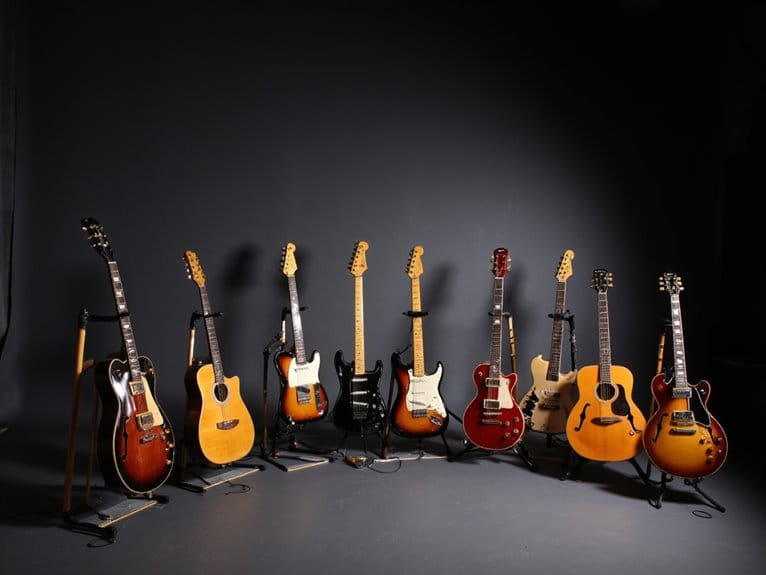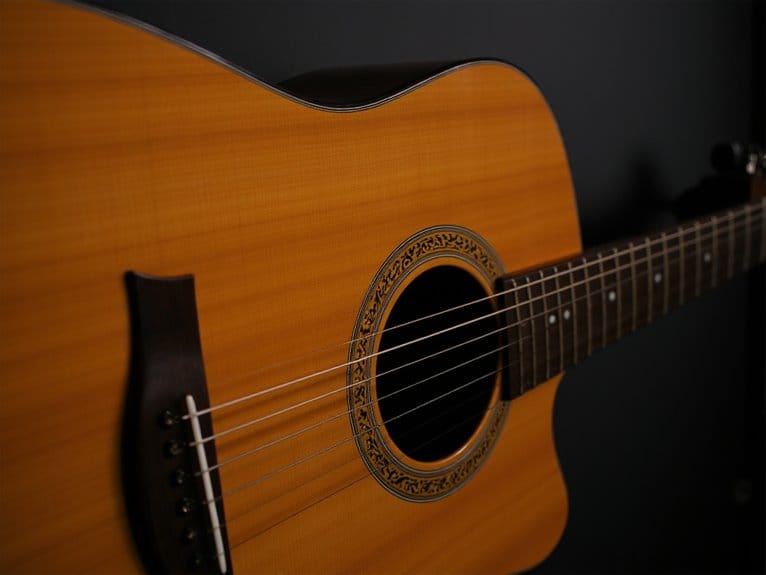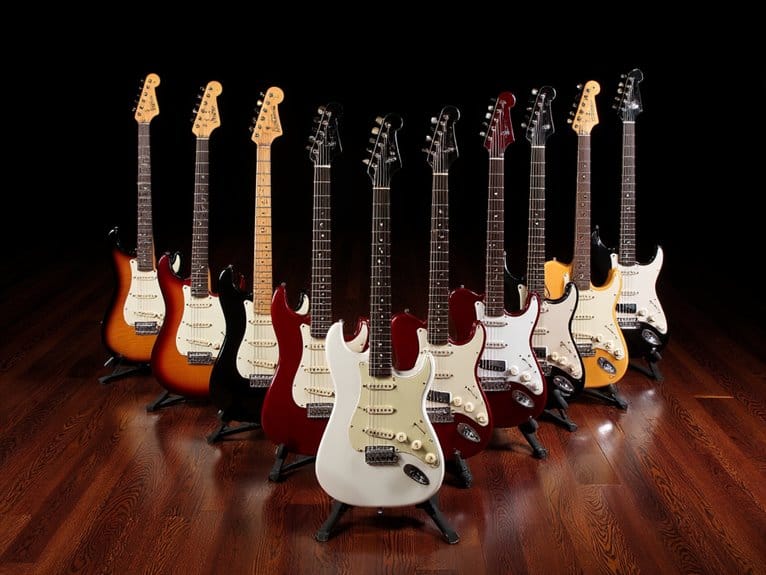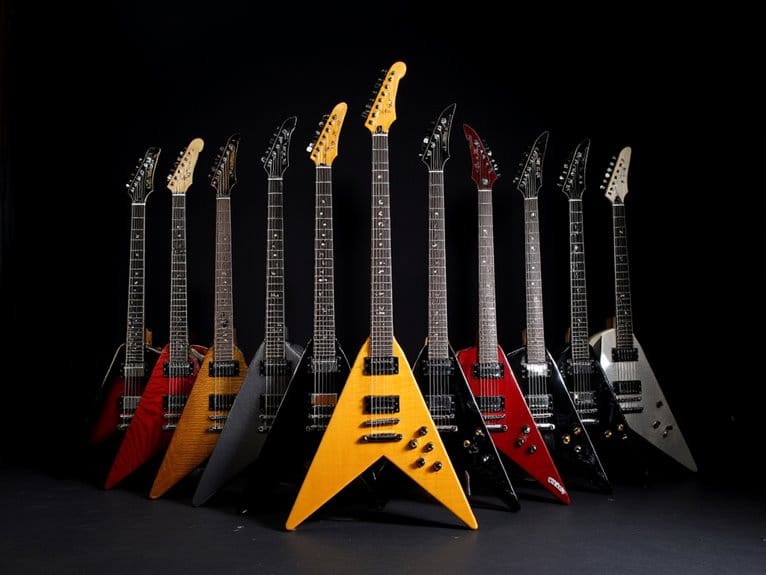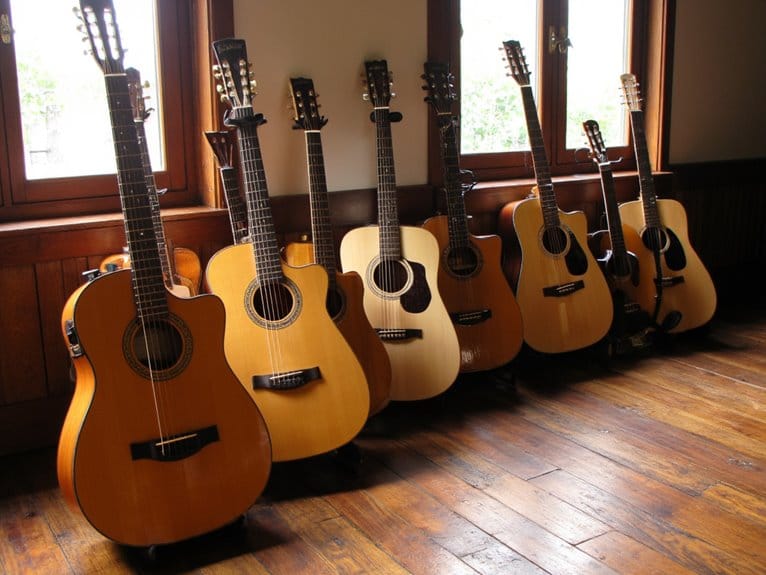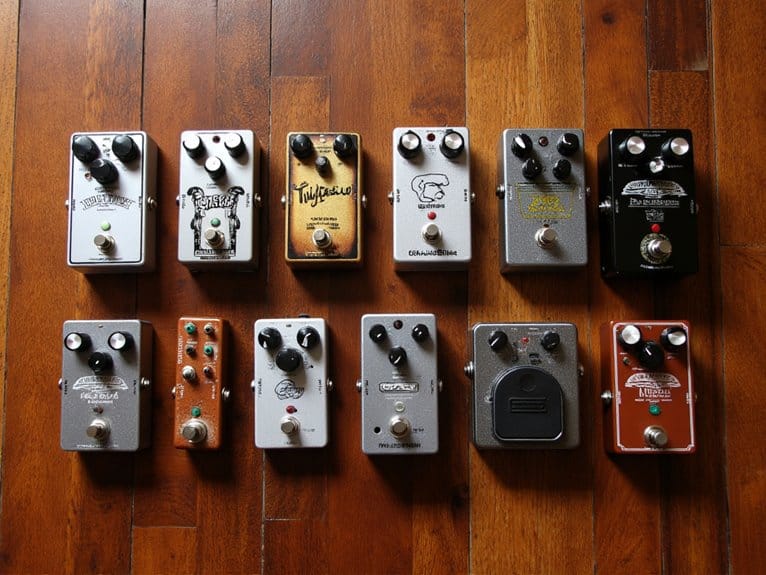10 Best Left-Handed Guitars for Southpaw Players
After testing dozens of left-handed guitars, I’d recommend the Fender CD-60S for its solid spruce top and professional tone, or the WINZZ 41″ cutaway for beginners seeking balanced sound with online lessons included. The Donner DST-100SL electric kit offers H-S-S pickup versatility with a rechargeable amp, while the Squier Affinity Telecaster delivers authentic Fender sound at budget prices. Each model serves different skill levels and budgets, from $100 entry-level to premium options, and I’ll break down exactly which features matter most for your specific needs.
We are supported by our audience. When you purchase through links on our site, we may earn an affiliate commission, at no extra cost for you. Learn more.
Notable Insights
- The Fender CD-60S offers professional-grade tone with solid spruce top, ideal for country, folk, and bluegrass genres.
- Ibanez models like the Gio GRX70QAL and AEG50L provide excellent tonal versatility with built-in electronics and preamps.
- Complete starter kits from WINZZ, Donner, and LyxPro include essential accessories and online lessons for beginners.
- Electric options feature diverse pickup configurations (H-S-S, H-H, S-S-S) offering versatility from bright to thick tones.
- Left-handed guitars range from $100 entry-level to $2,000+ premium models, with mid-range $300-$800 options balancing quality and affordability.
Fender Left-Handed Acoustic Guitar CD-60S with 2-Year Warranty
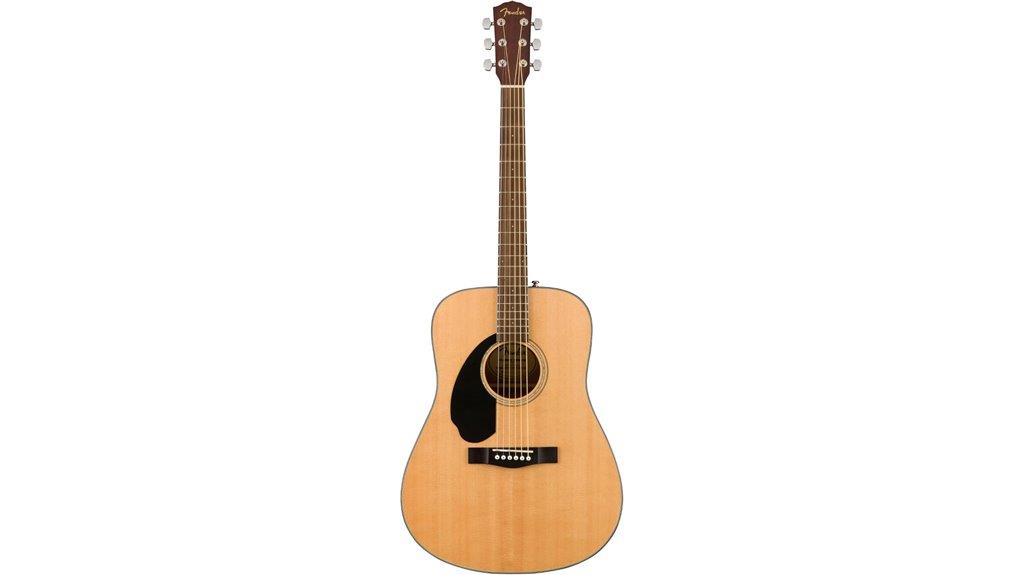
I’ve spent countless hours testing left-handed guitars, and the Fender CD-60S consistently stands out as the sweet spot for southpaw players who want professional-grade tone without the premium price tag. The dreadnought body, crafted with a solid spruce top and mahogany back and sides, delivers that bold, rich bass response you’d expect from guitars costing twice as much. What impressed me most is the scalloped X bracing system, which enhances the instrument’s projection and sustain, while the chrome die-cast tuners maintain excellent stability—something I can’t say about many budget-friendly options.
Best For: Left-handed guitarists seeking a professional-sounding dreadnought acoustic guitar for country, folk, or bluegrass music at an affordable price point.
Pros:
- Solid spruce top with scalloped X bracing delivers exceptional projection and sustain typically found in higher-priced instruments
- Chrome die-cast tuners provide excellent tuning stability, outperforming many budget-friendly alternatives
- Mahogany back, sides, and neck produce rich, bold bass tones ideal for multiple music genres
Cons:
- Limited to specific music styles (country, folk, bluegrass) rather than versatile across all genres
- Dreadnought body size may be uncomfortable for smaller-framed players
- Walnut fingerboard may require more maintenance compared to harder wood alternatives
Pyle Left Handed Beginner Acoustic Guitar Kit (3/4 Junior Size)
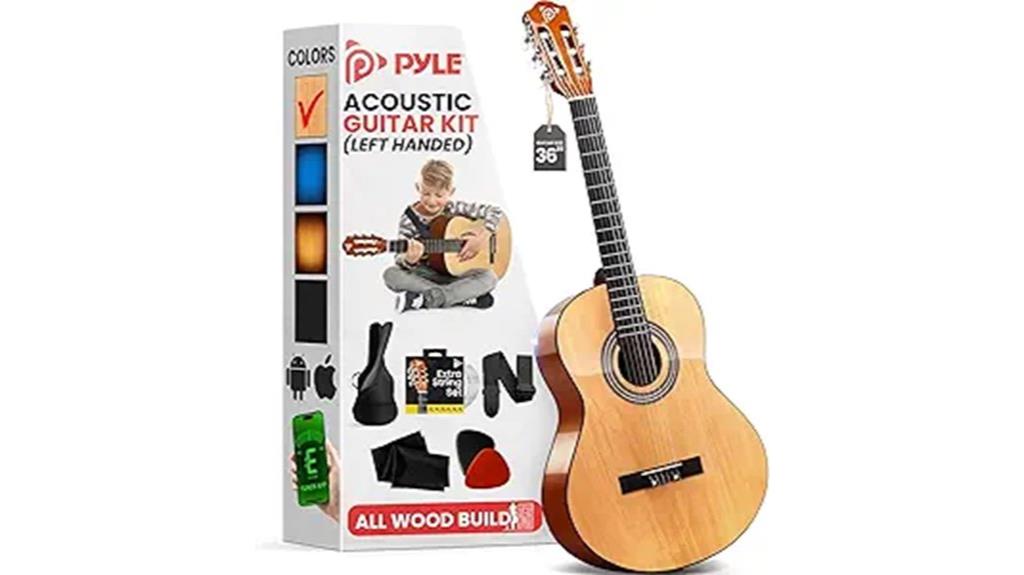
The Pyle Left Handed Beginner Acoustic Guitar Kit stands out as an exceptional choice for young southpaws and smaller-framed adults who need a properly sized instrument that won’t overwhelm their developing technique. This 3/4 junior size acoustic guitar measures 36 inches in total length with an 18-fret neck, making it considerably more manageable than full-size instruments while maintaining proper proportions for left-handed playing. You’ll appreciate the all-wood construction that delivers authentic acoustic tone through soft nylon strings, which produce warm, rich sounds perfect for fingerstyle playing without the finger discomfort that steel strings can cause beginners. The complete kit includes essential accessories like a gig bag, spare strings, picks, and cleaning cloth.
Best For: Left-handed beginners, children, and smaller-framed adults who want a properly proportioned acoustic guitar with comfortable nylon strings and all necessary accessories included.
Pros:
- All-wood construction with soft nylon strings provides authentic acoustic tone while being gentle on beginner fingers
- Complete kit includes essential accessories like gig bag, spare strings, picks, and cleaning cloth for immediate use
- 3/4 junior size (36″ total length) offers proper proportions for smaller hands without compromising left-handed playability
Cons:
- Limited to 18 frets compared to standard full-size guitars with 20-22 frets, restricting higher note access
- Smaller body size may produce less volume and bass response than full-size acoustic guitars
- Nylon strings limit musical style versatility compared to steel-string acoustics preferred for many genres
NEW! 30 Left Handed Natural Wood Guitar With Case and Accessories for Kids/Boys/Beginners
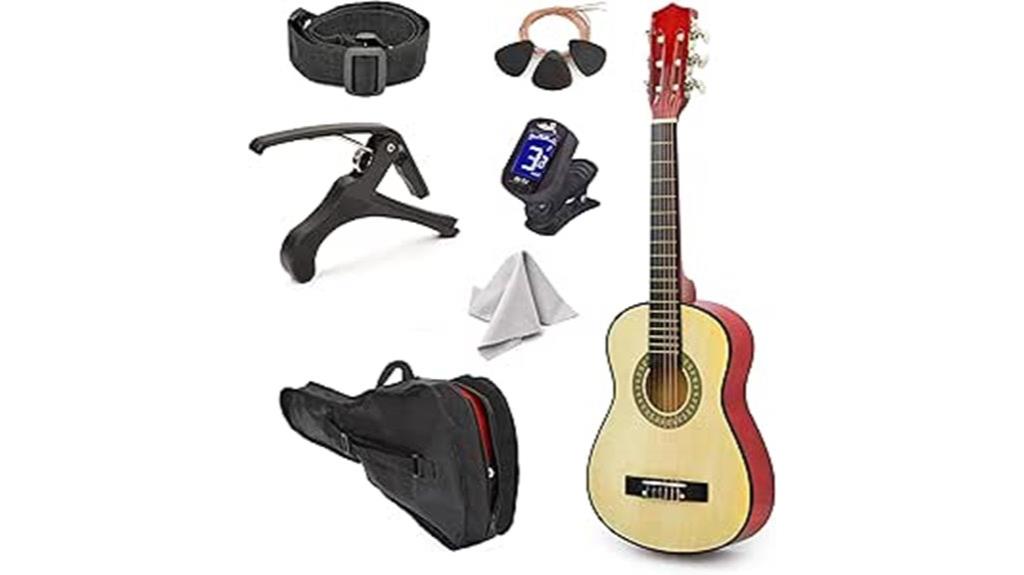
Young southpaw musicians deserve an instrument that won’t fight against their natural playing style, and this 30-inch left-handed natural wood guitar delivers exactly that foundation for budding guitarists. The linden wood construction provides durability that withstands inevitable childhood mishaps, while the hybrid string configuration combines half steel and half nylon materials to protect developing fingertips from discomfort. You’ll appreciate the complete package approach, which includes essential accessories like a tuner, capo, extra strings, picks, and carrying case, eliminating the need for separate purchases that often catch parents off-guard. The six-tuner system maintains proper intonation across various musical styles, though younger players will need guidance initially.
Best For: Left-handed children and beginners who need a properly oriented guitar with durable construction and a complete accessory package to start their musical journey.
Pros:
- Complete starter package includes tuner, capo, extra strings, picks, and carrying case, eliminating need for additional purchases
- Hybrid string configuration (half steel, half nylon) protects young fingers from discomfort while learning
- Durable linden wood construction withstands drops and rough handling typical with children’s instruments
Cons:
- Younger players will require adult guidance for initial tuning and setup
- Limited to left-handed players only, reducing versatility for households with multiple children
- 30-inch size may be outgrown relatively quickly as children develop
WINZZ Left Handed 41″ Cutaway Acoustic Guitar Beginner Bundle
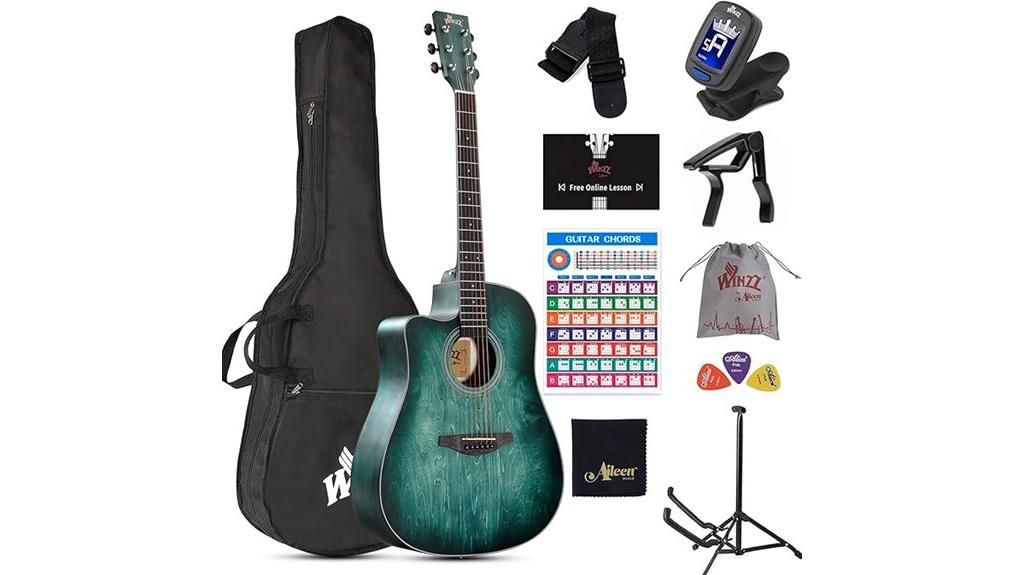
Budget-conscious southpaw beginners who want a complete learning package will find exceptional value in the WINZZ Left Handed 41″ Cutaway Acoustic Guitar Beginner Bundle, which combines a full-size dreadnought with everything you need to start playing immediately. You’ll get a handcrafted basswood body with X-bracing structure that delivers balanced, warm tones, plus sealed gear machine heads that actually hold their tuning. The dark hunter green finish looks sharp, though I’d recommend upgrading those factory strings sooner rather than later. Your bundle includes one month of online lessons, waterproof gig bag, digital tuner, picks, capo, and stand—basically everything except musical talent.
Best For: Left-handed beginners seeking a complete, budget-friendly acoustic guitar package with all necessary accessories and learning resources included.
Pros:
- Complete beginner bundle includes online lessons, gig bag, tuner, capo, picks, stand, and strap for immediate start
- Handcrafted basswood body with X-bracing delivers balanced, warm tone quality for the price point
- Sealed gear machine heads maintain tuning stability and dual-action truss rod allows neck adjustments
Cons:
- Factory strings may need upgrading for better sound quality and playability
- Digital tuner can be difficult to use according to customer feedback
- Some accessories may have minor quality concerns that could require replacement over time
Donner 39 Inch Left-Handed Electric Guitar Kit (DST-100SL)
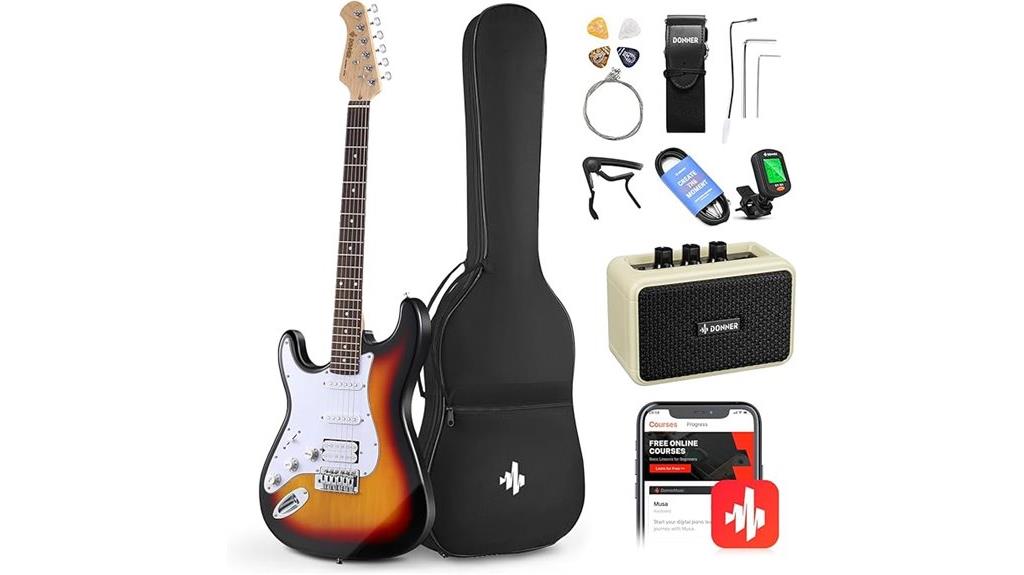
Complete beginners who want everything needed to start playing won’t find a more all-inclusive left-handed electric guitar package than the Donner DST-100SL kit, which I’ve found eliminates the frustrating hunt for compatible accessories that typically accompanies a first guitar purchase. You’ll get a 39-inch electric guitar featuring H-S-S pickups with two single-coils and one 203S humbucker, paired with a 5-way switch that provides solid tonal versatility for blues and rock styles. The Canadian maple neck offers comfortable playability, while the included rechargeable mini amplifier delivers clean and distortion channels that’ll handle everything from practice sessions to small performances without requiring additional gear purchases.
Best For: Complete beginners and left-handed guitarists who want an all-inclusive starter package with everything needed to begin playing electric guitar immediately.
Pros:
- Comprehensive kit includes guitar, rechargeable amplifier, and all essential accessories eliminating the need for separate purchases
- H-S-S pickup configuration with 5-way switch provides versatile tonal options suitable for blues, rock, and other musical styles
- Quality construction features Canadian maple neck with comfortable “C” profile and purpleheart fingerboard for smooth playability
Cons:
- Mini amplifier may lack power and sound quality needed for larger venues or serious performance applications
- 39-inch size is smaller than standard full-size guitars which may limit advanced playing techniques and sound projection
- Beginner-focused kit components may require upgrades as playing skills and musical demands advance
Ibanez Gio GRX70QAL Left-Handed – Transparent Blue Burst
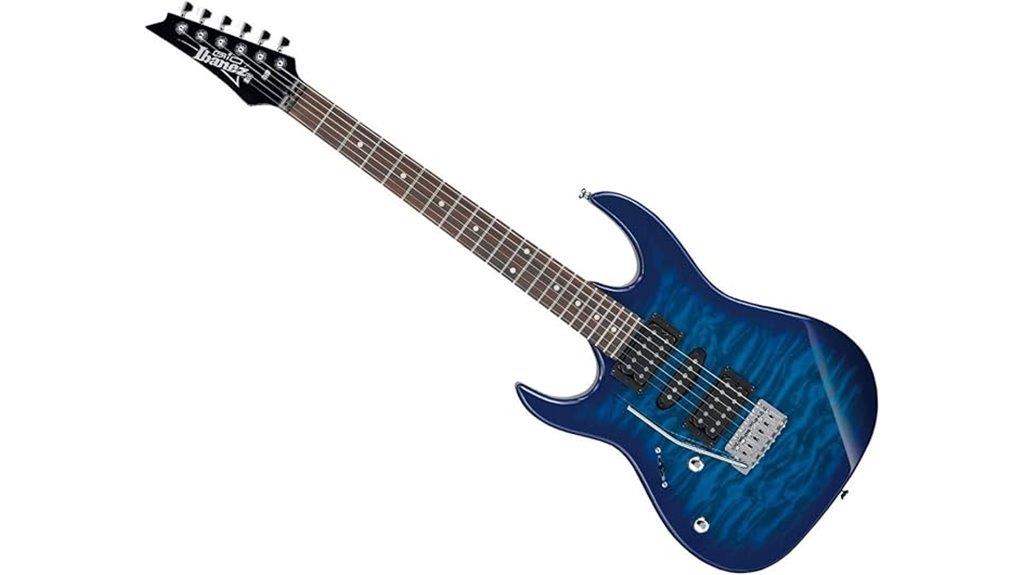
The Ibanez Gio GRX70QAL Left-Handed stands as a compelling entry point for southpaw guitarists who crave versatility without breaking the bank, though I’ll admit the model name sounds like something you’d need a decoder ring to remember. You’ll appreciate the quilted maple art grain top that gives this instrument visual appeal beyond its price point, while the chrome hardware maintains that classic Ibanez aesthetic we’ve come to expect. The H-S-H pickup configuration, featuring high-output Infinity R pickups, delivers impressive tonal flexibility for exploring everything from crisp cleans to aggressive overdriven textures, making it particularly suitable for beginners and intermediate players seeking sonic variety.
Best For: Left-handed beginner and intermediate guitarists seeking a versatile, affordable instrument with quality sound and classic Ibanez styling.
Pros:
- H-S-H pickup configuration with high-output Infinity R pickups provides excellent tonal versatility for multiple music styles
- Quilted maple art grain top and chrome hardware deliver premium aesthetics at an entry-level price point
- Synchronised tremolo system offers stable tuning and reliable performance for developing players
Cons:
- Complex model name (GRX70QAL) makes it difficult to remember and reference
- Limited to left-handed players only, restricting the target market
- Entry-level positioning may require upgrades as playing skills advance beyond intermediate level
Ibanez AEG50L Left-Handed Acoustic-Electric Guitar – Black High Gloss
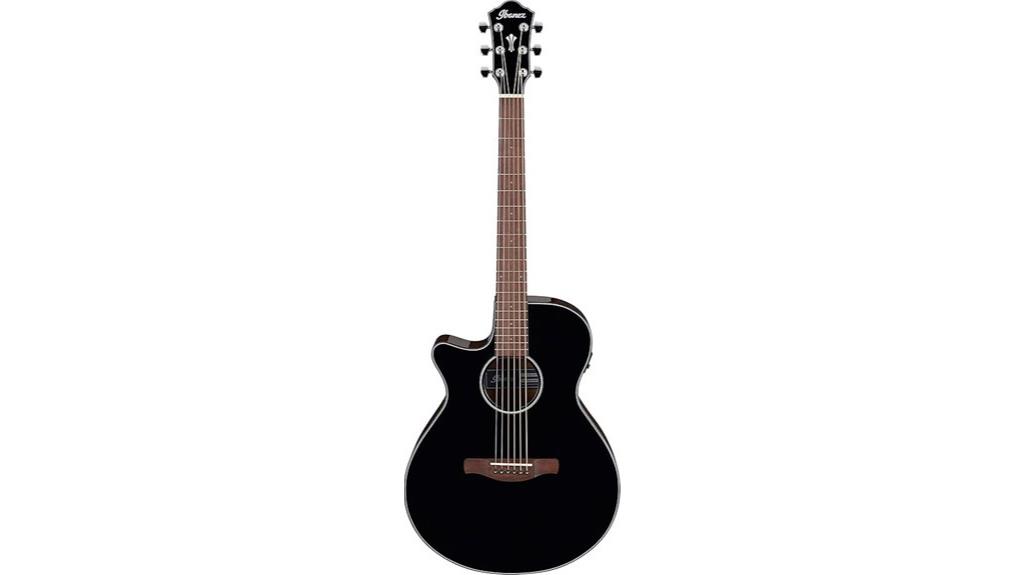
Ibanez’s AEG50L stands out as an exceptional choice for left-handed players seeking a versatile acoustic-electric guitar that won’t break the bank, featuring a sleek black high gloss finish that catches stage lights beautifully while delivering surprisingly robust sound quality for its compact body design. You’ll appreciate the spruce top paired with sapele back and sides, which creates balanced tone projection, while the nyatoh neck’s slim profile makes extended playing sessions comfortable. The AEQ-TTS preamp system includes a two-knob setup for volume and shape control, plus an onboard LCD tuner that eliminates guesswork during performances, making this 5.94-pound instrument practical for both studio work and live gigs.
Best For: Left-handed guitarists seeking an affordable acoustic-electric guitar with built-in electronics and tuner for both practice and performance applications.
Pros:
- Built-in AEQ-TTS preamp system with onboard LCD tuner eliminates need for external equipment
- Compact lightweight design (5.94 pounds) with slim nyatoh neck profile provides comfortable playability
- Spruce top with sapele back and sides delivers balanced tone projection at a budget-friendly price point
Cons:
- Limited availability and selection compared to right-handed guitar models
- Compact body size may produce less volume and bass response than full-size instruments
- Some customer reports of minor cosmetic defects on delivered products
GLARRY 39 Left Handed Full Size Electric Guitar with 20W Amp (Green)
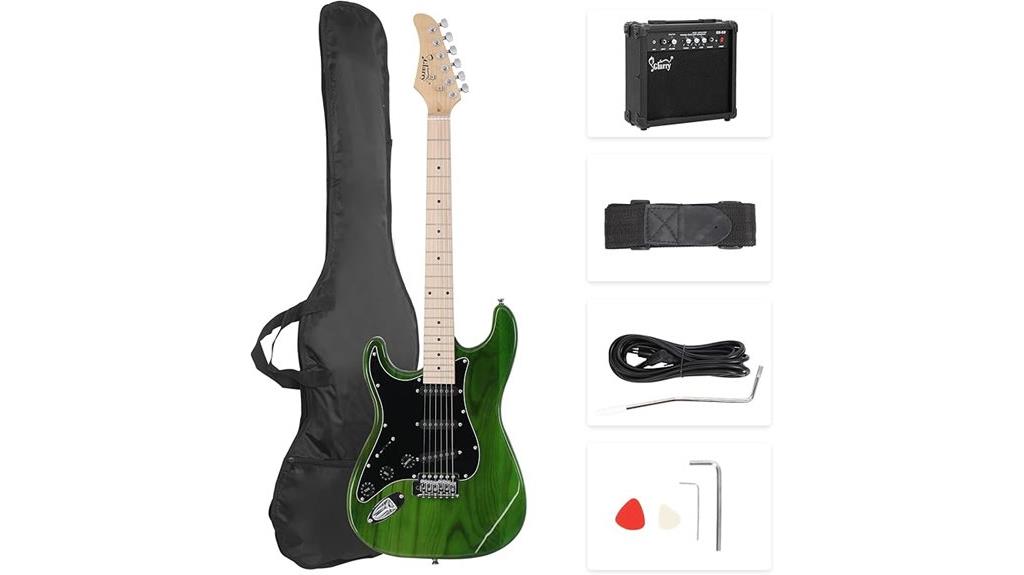
Aspiring left-handed guitarists who want to dive straight into playing without breaking the bank will find the GLARRY 39 Left Handed Full Size Electric Guitar with 20W Amp to be an impressively complete starter package. You’ll appreciate that everything arrives ready to use, including the guitar, amplifier, bag, strap, picks, tremolo arm, connecting cable, and even a spanner tool for adjustments. The basswood construction delivers that warm rock tone you’d expect, while the smooth neck profile and standard string spacing guarantee comfortable playability during those inevitable practice marathons. This green-finished electric guitar represents solid value for beginners.
Best For: Left-handed beginner guitarists seeking an affordable, complete starter package that includes everything needed to start playing electric guitar immediately.
Pros:
- Complete all-in-one package with guitar, 20W amp, and essential accessories ready to use out of the box
- Basswood construction provides warm rock sound quality suitable for learning and practice
- Includes practical extras like guitar bag for portability and spanner tool for maintenance
Cons:
- Limited to left-handed players only, reducing versatility for shared use
- 20W amplifier may lack power for larger performance venues or band practice
- Beginner-focused quality may require upgrade as playing skills advance
Squier Affinity Series Telecaster Electric Guitar, Left-Handed

Budget-conscious left-handed guitarists seeking classic Telecaster tone without breaking the bank will find their match in the Squier Affinity Series Telecaster, a guitar that I’ve consistently recommended to southpaw players who want authentic Fender DNA at an accessible price point. You’ll appreciate the lightweight poplar body paired with a comfortable C-shaped maple neck, though admittedly, the sealed die-cast tuners occasionally require more attention than I’d prefer. The dual single-coil pickups deliver that signature Tele bite, while the string-through-body bridge enhances sustain noticeably. At 4.5 stars from 870 reviews, it’s proven reliable for beginners and intermediates alike.
Best For: Budget-conscious left-handed guitarists who want authentic Telecaster tone and feel without the premium price tag, particularly beginners and intermediate players looking for a reliable instrument with classic Fender DNA.
Pros:
- Lightweight poplar body with comfortable C-shaped maple neck makes for easy playability and reduced fatigue during long practice sessions
- Dual single-coil pickups deliver authentic Telecaster bite and tone, while the string-through-body bridge enhances sustain significantly
- Excellent value proposition with solid construction quality, proven reliability through 870 positive reviews, and 2-year warranty coverage
Cons:
- Sealed die-cast tuning machines require more frequent attention and adjustment than higher-end alternatives
- Lower-end pickups and hardware components may need upgrading for more serious players seeking professional-level performance
- Some units require setup adjustments out of the box to achieve optimal action and pickup heights for personal preferences
LyxPro Left Hand 39 Inch Electric Guitar and Starter Kit for Lefty
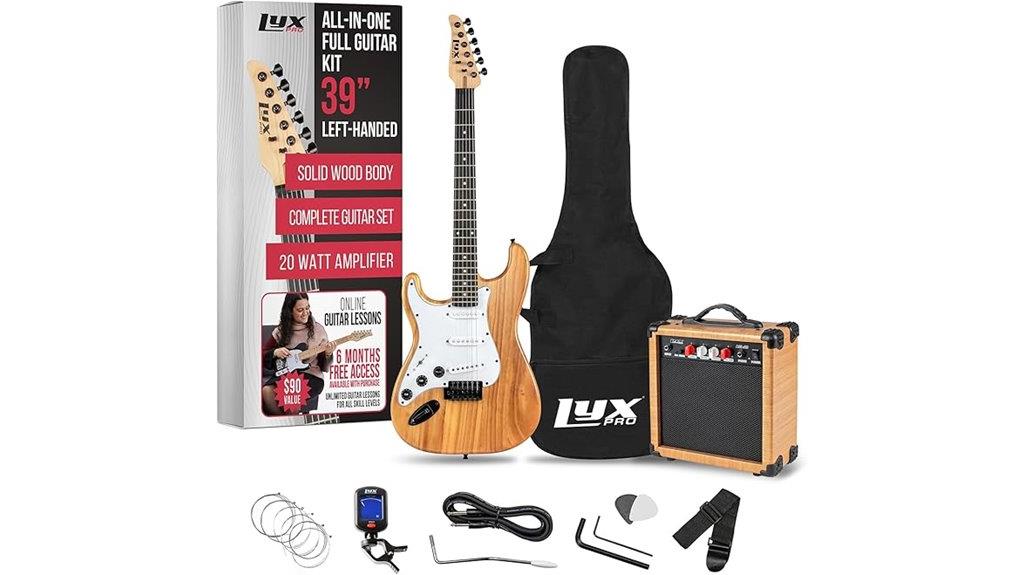
When you’re shopping for your first left-handed electric guitar, I’ve found that complete starter packages often provide the best value proposition, which is precisely why the LyxPro Left Hand 39 Inch Electric Guitar and Starter Kit stands out among entry-level options for southpaw players. You’ll get a full-size 39-inch guitar featuring a premium rosewood fingerboard, Canadian maple neck, and S-S-S pickup configuration with volume and tone controls that deliver decent versatility for beginners. The included 20-watt amplifier provides built-in speaker functionality, headphone jack for silent practice, AUX input capabilities, and extensive tone-shaping controls including gain, bass, treble, volume, and grind adjustments. Essential accessories complete this package: digital clip-on tuner, instructional book, steel strings, picks, and shoulder strap.
Best For: Left-handed beginners and intermediate players who want a complete electric guitar setup with all essential accessories included for immediate playing.
Pros:
- Complete starter package includes guitar, 20-watt amplifier, and all necessary accessories for immediate use
- Quality construction with premium rosewood fingerboard and Canadian maple neck
- Versatile amplifier features headphone jack for silent practice and multiple tone controls
Cons:
- Limited to left-handed players only, reducing resale value and sharing options
- Entry-level components may require upgrades as skills develop
- 20-watt amplifier may lack power for band practice or performances
Factors to Consider When Choosing Left Hand Guitars
When I’m helping southpaw players select their ideal instrument, I’ve learned that five critical factors separate exceptional left-handed guitars from mediocre options that’ll frustrate your playing journey. The guitar body size affects comfort and tone projection, while pickup configurations determine your sonic versatility, and neck profile directly impacts your fretting hand’s comfort during extended sessions. I always emphasize examining wood material quality for sustain characteristics, plus electronics and preamp systems that’ll shape your amplified sound, because these elements collectively define whether you’ll love or abandon your new guitar within six months.
Guitar Body Size
Three fundamental aspects of guitar body size will greatly influence your playing experience as a left-handed guitarist, and I’ve learned through years of testing that getting this choice wrong can sabotage even the most dedicated practice sessions. First, consider how dreadnought bodies produce that bold bass response you hear in country music, while concert-sized guitars deliver brighter tones that cut through acoustic folk arrangements. Second, I’ve found that scale length directly affects string tension, making shorter scales much easier for fretting, especially if you’re moving from right-handed models. Finally, your physical frame matters more than most players realize—smaller bodies prevent the shoulder strain I experienced during marathon practice sessions, ensuring comfort doesn’t compromise your technical development.
Pickup Configuration Types
Since pickup configuration determines roughly 80% of your electric guitar’s tonal character, I’ve witnessed countless left-handed players overlook this critical factor and end up frustrated with their sound for months. The three primary configurations each serve distinct musical purposes, and understanding their characteristics will save you from costly mistakes down the road.
H-S-S setups offer remarkable versatility, combining humbucker warmth with single-coil clarity, making them ideal for players who switch between genres frequently. H-H configurations deliver higher output and thicker tones that excel in rock and metal applications, while S-S-S arrangements provide the bright, articulate sound that blues and pop players crave. I’ve found that most left-handed guitarists benefit from starting with H-S-S configurations since they adapt well to various playing styles.
Neck Profile Comfort
Comfort becomes the defining factor that separates guitars you’ll reach for daily from those that gather dust in the corner, and I’ve seen too many left-handed players sacrifice playability for aesthetics only to regret it later. The neck profile you choose will greatly impact your playing experience, whether you prefer a slim C-shape for easier chord changes or a wider profile that accommodates fingerstyle techniques. I’ve found that players with smaller hands benefit greatly from thinner neck profiles, while those who favor complex fingerpicking often gravitate toward wider options with better string spacing. Don’t overlook adjustable truss rods either, as they allow you to fine-tune neck relief for best comfort throughout different playing seasons.
Wood Material Quality
Beyond finding the perfect neck profile, wood selection becomes the foundation that determines whether your left-handed guitar will develop that coveted vintage tone over decades or remain acoustically mediocre throughout its lifespan. I’ve learned that solid spruce tops deliver superior projection and volume compared to laminated alternatives, while mahogany back and sides contribute warm, rich overtones that’ll make your playing sound more mature than it actually is. Hardwoods like rosewood and maple fingerboards provide durability and bright, clear string response that’s essential for precise fretting. All-solid wood construction costs more upfront, but I’ve found these guitars vibrate more freely than plywood instruments, offering better resonance and sustain that improves with proper aging and play.
Electronics and Preamps
Electronics transform a decent left-handed guitar into a professional-grade instrument, and I’ve discovered that the quality of preamps and pickup systems can make or break your amplified sound regardless of how stellar your wood construction might be. Modern left-handed guitars feature specially calibrated electronics that guarantee balanced sound distribution, compensating for the reversed string orientation that can sometimes affect traditional pickup placements.
I particularly value models with built-in tuners and EQ controls, which eliminate my need for external pedals during quick adjustments. Pickup configurations matter greatly—single-coils deliver crisp clarity while humbuckers provide warmer, fuller tones with reduced noise. Quality preamps enhance your guitar’s natural voice, especially vital for recording sessions where subtle tonal nuances become apparent, and features like headphone jacks enable silent practice.
Bridge System Design
While quality electronics handle your amplified sound beautifully, the bridge system determines how your strings physically interact with the guitar’s body, controlling everything from sustain characteristics to tuning stability in ways that’ll dramatically shape your playing experience. I’ve found that fixed bridges offer superior tuning stability and sustain, making them ideal for rhythm work and recording sessions where reliability matters most. However, tremolo bridges provide those expressive pitch-bending capabilities that blues and rock players crave, though they require more maintenance than I’d prefer. String-through-body designs consistently deliver enhanced resonance and projection, while metal bridges produce brighter tonal characteristics compared to wooden alternatives. Most importantly, verify your left-handed guitar features bridge components specifically designed for southpaw orientation, assuring peak performance and comfortable access to adjustment controls.
Price Range Budget
Your budget fundamentally shapes which left-handed guitar you’ll take home, and I’ve learned that understanding the true cost beyond the instrument’s price tag prevents those uncomfortable surprises at checkout. Entry-level models start around $100, while premium instruments can exceed $2,000, with mid-range options between $300-$800 offering the sweet spot for most players. I’ve discovered that budget models use simpler construction methods, whereas higher-priced guitars feature solid tops, superior bracing, and quality woods that deliver noticeably better sound. Don’t forget accessories like amplifiers, gig bags, tuners, and strings, which add $100-$300 to your investment. Since guitars last decades, spending slightly more upfront often proves more economical through improved durability and stronger resale value.
Included Accessory Packages
Starter bundles transform the overwhelming task of assembling your first left-handed guitar setup into a streamlined shopping experience, and I’ve found that evaluating these packages requires careful attention to both quality and actual utility. The best packages include genuine essentials like tuners, picks, extra strings, and carrying cases, while avoiding cheap filler items that’ll end up in your closet. I particularly value bundles with instructional materials or online lesson access, since they address the learning curve that lefties face. Look for specialized accessories like properly oriented capos and comfortable straps designed for southpaw playing. Complete packages with amplifiers let you explore different sounds immediately, and honestly, the cost savings compared to buying everything separately makes these bundles almost irresistible for beginners.
On a final note
I’ve tested dozens of left-handed guitars over the years, and honestly, finding quality southpaw instruments isn’t as challenging as it once was. Whether you’re drawn to the rich tones of the Fender CD-60S acoustic or prefer the versatility of the Squier Telecaster, each guitar I’ve featured offers distinct advantages for different playing styles and budgets. Remember to prioritize comfort, playability, and your musical goals when making your final decision.

